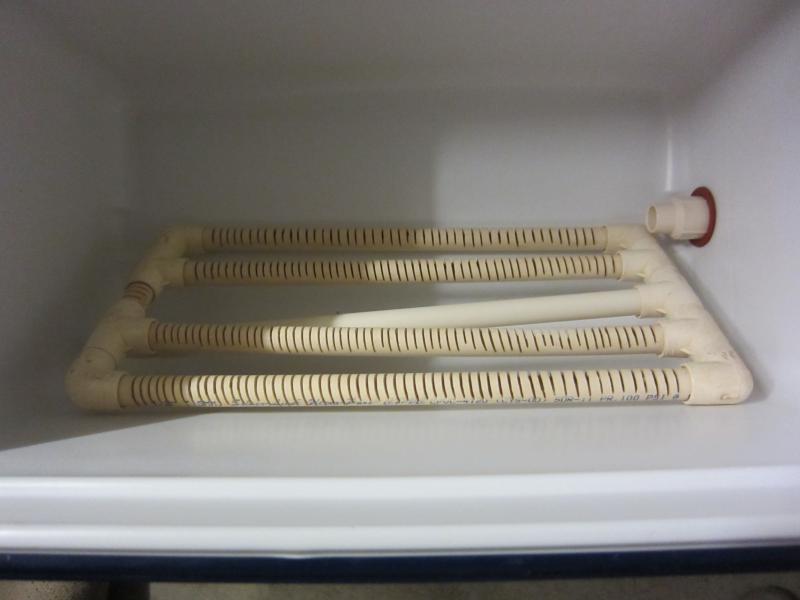jonnojohnson
Well-Known Member
I've been gradually modifying my AG cooler mash tun system to try to get more accurate but my mash efficiency always seems to be stuck in the low to mid 60's. I'm not shooting for anything beyond 80% but 75% would be nice and I can't see why I can't achieve that based on what others have said.
Attached are pics of my mash lauter tun with one showing the collection cpvc piping turned on its side. The piping provides reasonable coverage I think and the slits are right against the base of the cooler. The cooler is a Coleman Premium 28Qt.
I have a second identical cooler which serves as the HLT.
I have a dial thermometer and a glass floating thermometer and I always use both for each stage (calibrating the dial from the floating at the start).
The only weird thing I've noticed with temps is that the floating tends to read lower than the dial in the mash. In hot water they read the same but put them into the mash and they seem to differ. Any ideas why? I let them set deep in the mash for a while but they never seem to agree and the glass floating thermom is always low (by as much as 10degF!).
For this last recipe (Austin Homebrew Imperial Agave Wit) the grain bill was 1 lb flaked oats, 4.75 lbs Belgian Pale Ale Malt, 3.75 lbs White Wheat.
I estimate (see comment on thermometers) my mash temp was 150-155 for just over an hour. I had about 14 quarts of mash water for the 9.5 lbs grain.
I then fly-sparged for over 1.5-2 hrs with water at about 170 degF. For the sparge I run the water from the HLT through a short piece of Silicon tube onto a plastic lid sitting on top of the mash, with the mash tun lid almost closed to keep the temp.
Normally I would run off 6.25 gallons but this time I wanted to gather all the sugars I could so I went over by a bit and then boiled down to 6.25G. I then measured the gravity using my spiffy new (calibrated) refractometer once the sample had been cooled down.
I calculated that the max yield for this grain bill @ 6.35G should have been around 1.055 but I measured 1.036 for an efficiency of >65%.
I'm really frustrated as I've tried to be as careful as possible when measuring temps and volumes. I'm pretty sure my mash-lauter tun design should be capable of better. I've sparged as slow as I can and I still seem to be stuck with a low efficiency. I've read some saying that grain crush can be a big factor. Has anyone else reported consistently low efficiencies from Austin Homebrew? I kind of doubt that's the problem to be honest but I'm stuck right now.
HELP!


Attached are pics of my mash lauter tun with one showing the collection cpvc piping turned on its side. The piping provides reasonable coverage I think and the slits are right against the base of the cooler. The cooler is a Coleman Premium 28Qt.
I have a second identical cooler which serves as the HLT.
I have a dial thermometer and a glass floating thermometer and I always use both for each stage (calibrating the dial from the floating at the start).
The only weird thing I've noticed with temps is that the floating tends to read lower than the dial in the mash. In hot water they read the same but put them into the mash and they seem to differ. Any ideas why? I let them set deep in the mash for a while but they never seem to agree and the glass floating thermom is always low (by as much as 10degF!).
For this last recipe (Austin Homebrew Imperial Agave Wit) the grain bill was 1 lb flaked oats, 4.75 lbs Belgian Pale Ale Malt, 3.75 lbs White Wheat.
I estimate (see comment on thermometers) my mash temp was 150-155 for just over an hour. I had about 14 quarts of mash water for the 9.5 lbs grain.
I then fly-sparged for over 1.5-2 hrs with water at about 170 degF. For the sparge I run the water from the HLT through a short piece of Silicon tube onto a plastic lid sitting on top of the mash, with the mash tun lid almost closed to keep the temp.
Normally I would run off 6.25 gallons but this time I wanted to gather all the sugars I could so I went over by a bit and then boiled down to 6.25G. I then measured the gravity using my spiffy new (calibrated) refractometer once the sample had been cooled down.
I calculated that the max yield for this grain bill @ 6.35G should have been around 1.055 but I measured 1.036 for an efficiency of >65%.
I'm really frustrated as I've tried to be as careful as possible when measuring temps and volumes. I'm pretty sure my mash-lauter tun design should be capable of better. I've sparged as slow as I can and I still seem to be stuck with a low efficiency. I've read some saying that grain crush can be a big factor. Has anyone else reported consistently low efficiencies from Austin Homebrew? I kind of doubt that's the problem to be honest but I'm stuck right now.
HELP!




